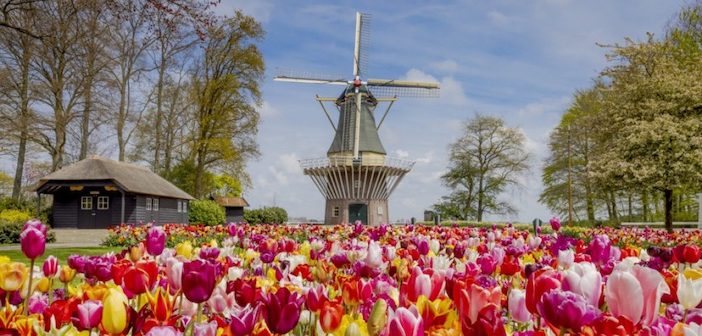With spring in full bloom, Alice Payne visits a city whose attractions are as numerous as its canals, and all the better at this time of year…
Amsterdam is a city with many sides: it’s not often a place is referred to as both ‘the Venice of the North’ and ‘the Vegas of Europe’, but ‘Mokum’ (as it’s also known) is intriguingly versatile. Some people visit for its famous appeltaarts, others for its brownies – but beyond these enticements is an immaculate city with some of the best museums in Europe, a network of canals fringed with iconic architecture, a compelling history, a thriving café culture and access to the one of the world’s largest flower gardens. Which is quite a lot to pack into one weekend, but I’m here to try.
I last experienced Amsterdam as a child and have three enduring memories; ice skating outdoors, eating hand-made chocolates, and inadvertently passing shops that made me choke on my chocolate. Many years later, I’m reorienting myself with a stroll through the city, this time avoiding De Wallen, which is the city’s tourist centre but also home to one of its red-light districts.
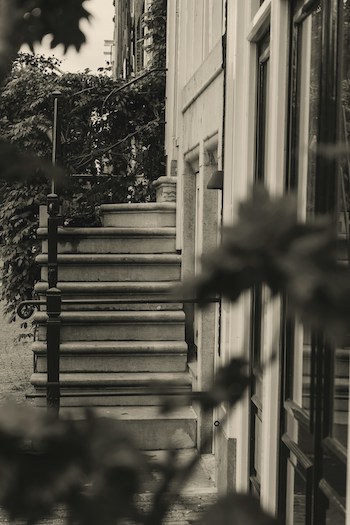
Grachtengordel detail (photo by Pourya Gohari, courtesy of Unsplash)
I head instead to Negen Straatjes, an attractive neighbourhood inside the canal ring, formed of nine streets crisscrossing the water. Formerly a tanning district, the area is part of Grachtengordel – a UNESCO-listed zone that dates back to the early 17th century. Today, stylish boutiques, craft stores and independent cafes line the narrow, red-brick streets, making it easy to while away a morning wandering from shop to shop, joining the queue for Fabel Friet’s famous Dutch fries and admiring the wonky buildings that have taken to leaning wearily against each other over time.
On a map, Amsterdam’s centre resembles a liquid cobweb, with rings of canal spreading unevenly outwards as though made by an erratic spider. Exploring on foot brings the challenge of being pinged at regularly by cyclists, so the best way to soak up the city is by boat. There are numerous options to choose – from luxury private cruises to small, self-driving motors. Happy to let someone else do the work, I opt for a 75-minute tour with Lovers, whose glass-topped vessel does inadvertently take on a romantic air in the light afternoon drizzle.
Aside from a pang of envy when the family opposite unpacks a picnic (note for next time), the combination of gliding leisurely along the water while learning about Amsterdam’s Golden Age and seeing its inimitable architecture from a clear vantage point is thoroughly enjoyable. The Damrak houses – a row of 17th century red, ochre and brown buildings whose subsidence gives them the appearance of being mid-dance – are a particular highlight.
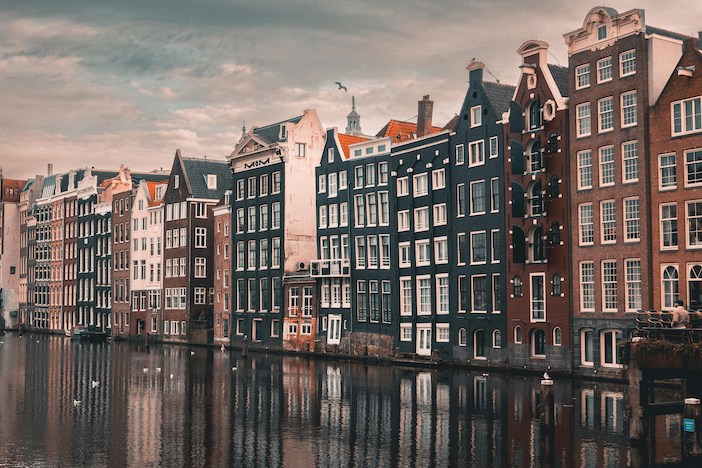
Damrak houses (photo by Jan Willem van Braak, courtesy of Unsplash
As the sun reappears I head to the hidden courtyard of Bejinghof – one of Amsterdam’s free and lesser-known attractions. This large, peaceful enclave dates back to the early 14th century when it was created for a Catholic sisterhood who lived like nuns. Today, it’s still occupied by single women and exudes an air of calm sanctity, metres from Amsterdam’s heaving high streets. Attractive gabled brick buildings line the courtyard’s grassy square like a Dutch village green. In the corner is Amsterdam’s oldest surviving house – a black timber home built in 1420. Nearby, behind the façade of two buildings is the secret church – a surprisingly large chapel with fine artwork, stained glass windows and a beautifully engraved wood pulpit. It is here the women worshipped clandestinely when Catholicism was banned.
Amsterdam’s culinary scene is diverse, in part due to the Netherlands’ global diaspora. Over the course of the weekend I enjoy food from around the world, but the most memorable dining experience takes place at Restaurant Ambassade – an upscale establishment on Herengracht, serving fresh, locally-sourced ingredients inspired by classic French dishes. Part of the boutique Hotel Ambassade, the former townhouse has a sophisticated but friendly atmosphere, with elegant interiors combining colourful modern art, crystal chandeliers and parquet flooring.
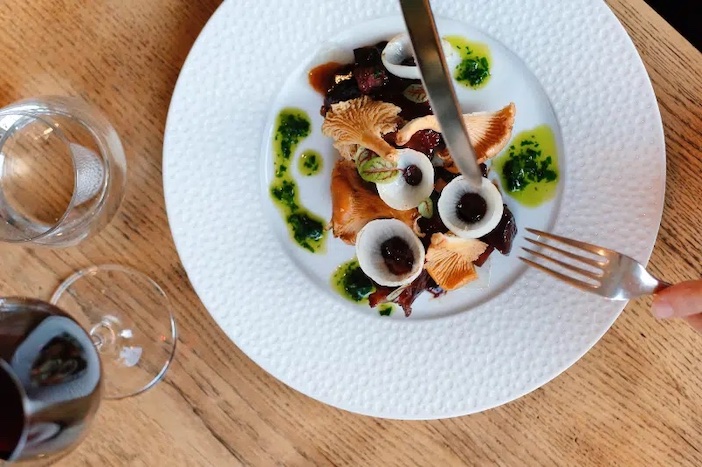
The restaurant’s menu changes regularly to incorporate seasonal ingredients. As it is Spring, I’m presented with burrata in gazpacho of cucumber, watercress and green tomato, along with a dish of perfectly succulent scallops and ravioli in a silken seafood sauce, followed by the tenderest lamb ribs, and a desert of light praline Paris Brest with whipped coffee ice cream. If it weren’t excessive, I’d come back every day.
Instead, the following morning I walk off dinner with a stroll through the expansive Vondelpark – watching joggers, young families and avian inhabitants enjoy the park’s peaceful ponds and paths – before winding my way through De Pijp, a trendy residential area lined with cafes, bars and restaurants in the old latin quarter. My destination is Coffee & Coconuts, an airy three-storey restaurant housed in a former 1920s cinema, whose whitewashed walls, pale wood furniture, decorative ropes and lustrous plants are designed to evoke a castaway island.
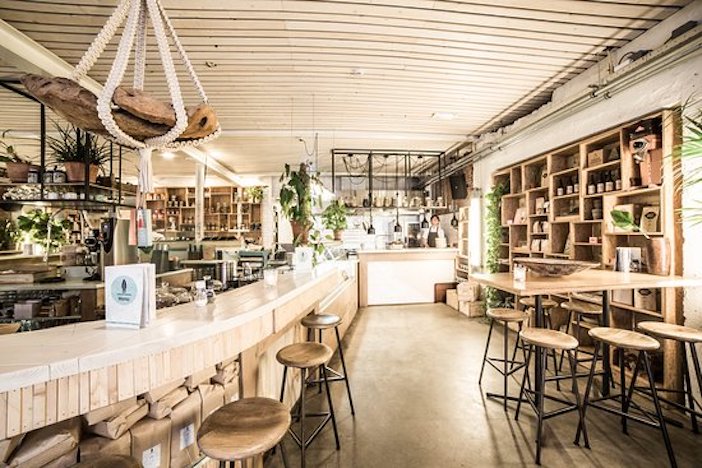
It’s a beloved neighbourhood spot and brunch is definitely a notch above the rest. There are the usual egg and avocado staples, along with some more tropical offerings, like the green coconut bowl, the mango chia pudding and coconut pancakes. The food and atmosphere are as enjoyable as each other and it would be easy to spend a couple of hours here, but I have a date with a few million tulips outside of the city and I’m feverish to get there.
Keukenhof, or the ‘Garden of Europe’, is only open in the Spring months because, although it displays some impressive rhododendrons, azaleas and camellias, the 32-hectare botanical garden’s main event is a flowering extravaganza of every shade and shape of tulip plausible. Seven million bulbs are planted annually and their collective bloom is such an arresting sight it makes the 17th century’s tulip mania almost seem reasonable.
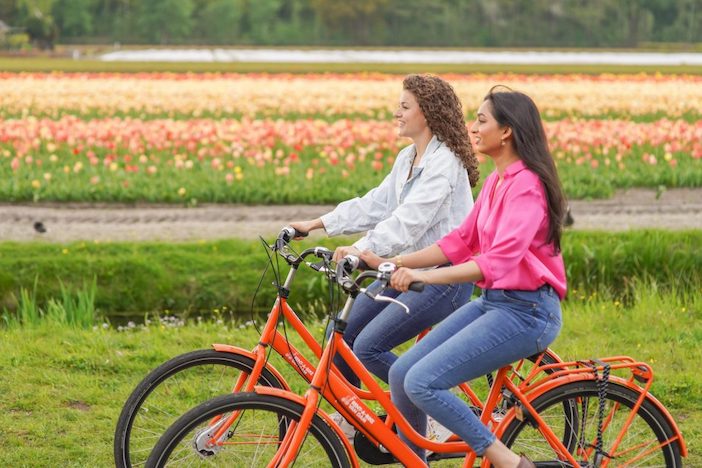
Cycling in Keukenhof
By early afternoon, the number of visitors feels on par with the bulbs so I hire a bike for some meditative time with nature, spending a few happy hours cycling around Lisse’s tulip, daffodil and hyacinth fields. Broad, colourful stripes of lilac, yellow, crimson, tangerine and pink stretch towards the horizon and transport me to the surreal technicolour cartoons of childhood, as the landscape takes on an almost magical air.
Walking through the Van Gogh museum the next day, the artist’s vivid take on nature echoes this sensation, particularly in the luminescence of pieces like Fields with Irises near Arles and Autumn Day. The four-storey museum houses 200 of Van Gogh’s paintings, including masterpieces such as Sunflowers, Almond Blossom and Self-Portrait as a Painter along with works that rarely make international exhibitions. Viewing so many of his pieces feels almost as transcendental as the flower fields, and the museum’s literature provides rich insight into the artist’s short but prolific life.
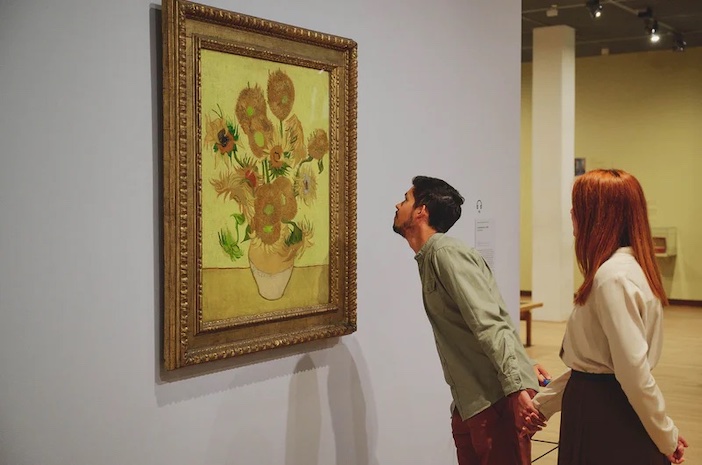
Van Gogh Museum (photo by David Stegenga, courtesy of Van Gogh Museum)
Like the ephemeral tulip season, my trip is over too soon and the list of things I didn’t see is as long as those I did. But this time I resolve not to leave it as long until my next visit, because no matter one’s age, Amsterdam is a city whose attractions will always elicit wonder.
For more information about Amsterdam visit www.iamsterdam.com. For information about the Van Gogh Museum visit www.vangoghmuseum.nl and for information about Keukenhof visit www.keukenhof.nl.
Header photo: Windmill at Keukenhof (courtesy of Keukenhof)

